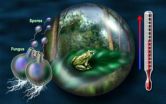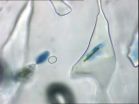(Press-News.org) PHILADELPHIA — An interdisciplinary group of researchers at the University of Pennsylvania has, for the first time, identified the neurological and cellular signaling mechanisms that contribute to satiety — the sensation of feeling full — and the subsequent body-weight loss produced by drugs used to treat type 2 diabetes. More comprehensive knowledge of these mechanisms could form the basis for anti-obesity medications.
The group was led by Matthew Hayes of the School of Medicine's Psychiatry Department, Harvey Grill of the Psychology Department in the School of Arts and Sciences and Kendra Bence of the School of Veterinary Medicine's Animal Biology Department. Their research was aided by a team of postdoctoral and doctoral fellows, as well as technicians and undergraduate students at Penn.
The study was published in the March 2 edition of the journal Cell Metabolism.
While no pharmaceutical treatment for obesity currently exists, type 2 diabetes drugs targeting the hormone glucagon-like-peptide-1, or GLP-1, for insulin production may hold promise. These drugs were known to promote weight loss, simply as a result of patients eating less. Researchers, however, could not explain exactly what caused this change in behavior.
Naturally occurring GLP-1 is made in primarily two distinct locations in the body, the gut and the brain. Much of the previous research in this area has focused on the former at the expense of the latter when attempting to identify the relevant population of GLP-1 receptors that may mediate the suppression in food intake by pharmaceutical GLP-1 drugs.
"Identifying both the site-of-action and mechanisms that accounts for the body weight loss of these GLP-1 drugs puts us one step closer to developing effective, FDA-approved, treatments for obesity," Hayes said.
"Ignoring the brain is not the right strategy, as these drugs are certainly engaging multiple, distributed centers in the brain governing energy balance regulation," Grill said.
The Penn group not only identified a necessary part of the brain which mediates the food intake suppression effect produced by these drugs, the nucleus tractus solitarius, or NTS, but also the cellular signaling pathways required for production of GLP-1's satiety effects.
"GLP-1's ability to alter these specific signaling pathways within the NTS of the brainstem may account for the suppression in food intake and body weight by altering the long-term neurochemistry and connectivity of this region of the brain with higher-order brain centers that also regulate energy balance," Bence said.
Many researchers have tried to determine precisely how GLP-1 and other satiating signals work, especially since in obese individuals, the brain fails to correctly perceive and respond to naturally occurring energy balance signals from the body. This faulty signaling underscores the importance of pharmacological treatments, such as the long-acting GLP-1 drugs that are effective in engaging brain signaling to reduce excessive food intake and possibly obesity.
That the Penn researchers were able to demonstrate a potential neurochemical mechanism of weight loss for a class of drugs already used in the treatment of type 2 diabetes provides a missing piece of the puzzle for future FDA-approved anti-obesity drugs.
"If we can identify other chemical signals or hormones that act on the same pathways that we've shown here, then by combined action you have a coordinated, orchestrated symphony of weight suppression," Hayes said.
INFORMATION:
This research was conducted by Hayes, Grill and Bence, along with Theresa M. Leichner, research specialist; Shiru Zhao, graduate student; Grace S. Lee and Amy Chowansky, undergraduate researchers; and Scott E. Kanoski, postdoctoral fellow, all in the Psychology Department, as well as Penn Vet's Derek Zimmer, research specialist, and Bart C. De Jonghe, postdoctoral fellow.
The research was supported by the National Institutes of Health, The Institute for Diabetes, Obesity and Metabolism at the University of Pennsylvania and The Obesity Society.
END
With the steep decline in populations of many animal species, scientists have warned that Earth is on the brink of a mass extinction like those that have occurred just five times during the past 540 million years.
Each of these "Big Five" saw three-quarters or more of all animal species go extinct.
In results of a study published in this week's issue of journal Nature, researchers report on an assessment of where mammals and other species stand today in terms of possible extinction compared with the past 540 million years.
They find cause for hope--and alarm.
"If ...
ATLANTA -- An enzyme viewed as an executioner, because it can push cells to commit suicide, may actually short circuit a second form of cell death, researchers at Emory University School of Medicine have discovered.
The finding could shift drug discovery efforts, by leading scientists to rethink how proposed anti-cancer and anti-inflammatory drugs that target the enzyme, called caspase 8, are supposed to work. The results are described in this week's Nature.
Caspase 8 has been described as "the killer you can't live without." This enzyme plays a key role in apoptosis, ...
Sea-ice algae – the important first rung of the food web each spring in places like the Arctic Ocean – can engineer ice to its advantage, according to the first published findings about this ability.
The same gel-like mucus secreted by sea-ice algae as a kind of antifreeze against temperatures well below minus 10 C is also allowing algae to sculpt microscopic channels and pores in ice that are hospitable to itself and other microorganisms.
Altering ice to their benefit should help sea-ice algae adapt to a warming world, which is good news for hungry fish and shellfish ...
Fraser Yachts is pleased to announce the following charters available for Mediterranean yacht charter and Caribbean yacht charter for 2011/12. M/Y Pamela V yacht is a luxurious 45.9m Hakvoort built yacht, available for yacht charter in the Bahamas and the British Virgin Islands. During the high season, it will be available for $235,000 per week and in the low season will go down to $220,000. Currently located in the Caribbean, this luxury yacht is due to be completed later this year. With the ability to sleep 8 guests in 4 staterooms, and 10 crew members, you can expect ...
Researchers have synthesized the vast literature on cancer to produce a next-generation view of the features that are shared amongst all cancer cells. These hallmarks of the disease provide a comprehensive and cohesive foundation for the field that will influence biomedical researchers in their quest for new cancer treatments.
The review article by Douglas Hanahan of École Polytechnique Fédérale in Switzerland and Robert Weinberg of the Whitehead Institute for Biomedical Research appears in the March 4th issue of Cell, a Cell Press publication. The new article updates ...
Low physical activity increases kidney transplant patients' likelihood of dying early, according to a study appearing in an upcoming issue of the Clinical Journal of the American Society Nephrology (CJASN). The results suggest that patients need to exercise to fend off an early death.
Inactive people in general face increased risks of developing cardiovascular disease and of dying prematurely. Individuals with chronic kidney disease—particularly those on dialysis—tend to get little exercise, but most increase their activity levels modestly after receiving a kidney transplant. ...
Evidence for a diversified sea-based economy among North American inhabitants dating from 12,200 to 11,400 years ago is emerging from three sites on California's Channel Islands.
Reporting in the March 4 issue of Science, a 15-member team led by University of Oregon and Smithsonian Institution scholars describes the discovery of scores of stemmed projectile points and crescents dating to that time period. The artifacts are associated with the remains of shellfish, seals, geese, cormorants and fish.
Funded primarily by grants from the National Science Foundation, the ...
Old Westbury, New York (Mar. 3, 2011) – Fossil records verify a long-standing theory that horses evolved through natural selection, according to groundbreaking research by two anatomy professors at New York College of Osteopathic Medicine (NYCOM) of New York Institute of Technology.
Working with colleagues from Massachusetts and Spain, Matthew Mihlbachler, Ph.D., and Nikos Solounias, Ph.D. arrived at the conclusion after examining the teeth of 6,500 fossil horses representing 222 different populations of more than 70 extinct horse species. The records, spanning the past ...
Optics researchers from the Universities of Glasgow and Bristol have developed an iPad application for accurate, easy and intuitive use of optical tweezers.
Optical tweezers, used to manipulate tiny particles through the use of highly focused laser beams, are the tool at the heart of much molecular biology – helping us to experiment with and better understand the microscopic processes of organisms.
Research published today, Friday 4 March 2011, in IOP Publishing's Journal of Optics, shows how a team of researchers has overcome the limitations of computer mouse and ...
Johns Hopkins scientists have discovered that PARIS — the protein — facilitates the most common form of Parkinson's disease (PD), which affects about 1 million older Americans. The findings of their study, published March 4 in Cell, could lead to important new targets for treatment.
Previous research has shown that a protein dubbed parkin protects brain cells by "tagging" certain toxic elements for natural destruction. Mutations in the parkin gene cause rare forms of PD that run in families, but its role remained unclear in sporadic late-onset PD, the prevalence of which ...



